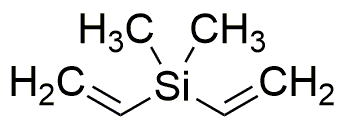Dimethyldivinylsilane is widely utilized in research focused on
- Silicone Production: This compound serves as a key intermediate in the synthesis of silicone polymers, which are used in various applications including sealants, adhesives, and coatings due to their excellent thermal stability and flexibility.
- Crosslinking Agent: It acts as a crosslinking agent in the production of elastomers, enhancing the mechanical properties and durability of rubber products used in automotive and industrial applications.
- Adhesive Formulations: Dimethyldivinylsilane is incorporated into adhesive formulations to improve adhesion properties, making it ideal for use in construction and manufacturing industries.
- Surface Modification: This chemical is used in surface modification processes to enhance the hydrophobicity and chemical resistance of materials, benefiting industries such as electronics and textiles.
- Research Applications: In academic and industrial research, it is utilized in the development of new materials and coatings, allowing scientists to explore innovative solutions in fields like nanotechnology and materials science.
General Information
Properties
Safety and Regulations
Applications
Dimethyldivinylsilane is widely utilized in research focused on
- Silicone Production: This compound serves as a key intermediate in the synthesis of silicone polymers, which are used in various applications including sealants, adhesives, and coatings due to their excellent thermal stability and flexibility.
- Crosslinking Agent: It acts as a crosslinking agent in the production of elastomers, enhancing the mechanical properties and durability of rubber products used in automotive and industrial applications.
- Adhesive Formulations: Dimethyldivinylsilane is incorporated into adhesive formulations to improve adhesion properties, making it ideal for use in construction and manufacturing industries.
- Surface Modification: This chemical is used in surface modification processes to enhance the hydrophobicity and chemical resistance of materials, benefiting industries such as electronics and textiles.
- Research Applications: In academic and industrial research, it is utilized in the development of new materials and coatings, allowing scientists to explore innovative solutions in fields like nanotechnology and materials science.
Documents
Safety Data Sheets (SDS)
The SDS provides comprehensive safety information on handling, storage, and disposal of the product.
Product Specification (PS)
The PS provides a comprehensive breakdown of the product’s properties, including chemical composition, physical state, purity, and storage requirements. It also details acceptable quality ranges and the product's intended applications.
Certificates of Analysis (COA)
Search for Certificates of Analysis (COA) by entering the products Lot Number. Lot and Batch Numbers can be found on a product’s label following the words ‘Lot’ or ‘Batch’.
Número de catálogo
Número de lote/lote
Certificates Of Origin (COO)
This COO confirms the country where the product was manufactured, and also details the materials and components used in it and whether it is derived from natural, synthetic, or other specific sources. This certificate may be required for customs, trade, and regulatory compliance.
Número de catálogo
Número de lote/lote
Safety Data Sheets (SDS)
The SDS provides comprehensive safety information on handling, storage, and disposal of the product.
DownloadProduct Specification (PS)
The PS provides a comprehensive breakdown of the product’s properties, including chemical composition, physical state, purity, and storage requirements. It also details acceptable quality ranges and the product's intended applications.
DownloadCertificates of Analysis (COA)
Search for Certificates of Analysis (COA) by entering the products Lot Number. Lot and Batch Numbers can be found on a product’s label following the words ‘Lot’ or ‘Batch’.
Número de catálogo
Número de lote/lote
Certificates Of Origin (COO)
This COO confirms the country where the product was manufactured, and also details the materials and components used in it and whether it is derived from natural, synthetic, or other specific sources. This certificate may be required for customs, trade, and regulatory compliance.

